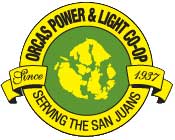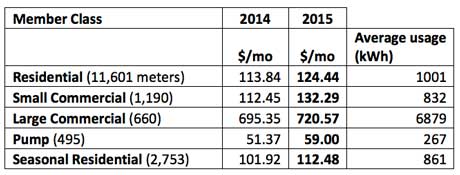Opalco Rate Increase Examined
Posted January 29, 2015 at 9:02 pm by Tim Dustrude
 Beginning in February, electric rates are going up. Residential members with average energy usage will see their OPALCO bill go up about $10/month. The rate increase is based on a number of factors, primarily making sure our revenue is adequate to meet budgeted expenses and covering the cost of upcoming submarine cable replacements over the next 30 years – which boils down to our ability to make loan payments. A Cost of Service Study was conducted in 2014 to make sure each member pays their fair share. All member classes are affected by the rate increase, as shown below.
Beginning in February, electric rates are going up. Residential members with average energy usage will see their OPALCO bill go up about $10/month. The rate increase is based on a number of factors, primarily making sure our revenue is adequate to meet budgeted expenses and covering the cost of upcoming submarine cable replacements over the next 30 years – which boils down to our ability to make loan payments. A Cost of Service Study was conducted in 2014 to make sure each member pays their fair share. All member classes are affected by the rate increase, as shown below.
WHAT CO-OP MEMBERS CAN EXPECT TO PAY IN 2015 (based on average usage):

This new rate structure also changes how we meet the co-op’s fixed operational costs. Currently, a large percentage of our revenue requirements are met through energy (kWh) usage. Bonneville Power Administration charges us for the kilowatt hours of energy used. This will stay relatively stable. However, over the next five years, the facility costs at OPALCO are going up incrementally and will make up a larger share of our fixed costs. Therefore, this shift in rate structure provides more revenue stability and predictability.
Please go to www.opalco.com/finances to read the detailed 2015 Budget and Rate Report. The full tariffs are also posted on our web site.
Warmer temperatures impacted energy sales last year. A $1.4 million revenue shortfall in 2014 was minimized by belt-tightening throughout the year as the number of “Heating Degree Days” were tracked and revenue reductions predicted. Hiring scheduled for 2014 was delayed, as well as some projects that were not critical to maintaining service levels.
“OPALCO’s budgeting is based not only on projected system growth, but also on how average monthly ambient temperatures will effect usage,” explained System Engineer Joel Mietzner. “We build in an error margin of +/- 5% for weather. In 2014, temperatures hit a historical high – and we hit the outer range of our margin for error.”
A headline in The New York Times (Jan 16, 2015) declared “2014 was the Warmest Year Ever Recorded on Earth” citing the annals of climatology record that stretches back to 1880. Local Scientist Russel Barsh of KWIAHT, published results of a five-year monitoring study that tracked rising sea surface temperatures around Indian Island (Islands Sounder, Dec 23, 2014) documenting a five degree increase in water temperature. “The water surrounding our islands acts as a thermal sink,” explained Mietzner, “keeping air temperatures warmer and creating a high pressure ceiling that deflects typical fall, winter and spring storms.”
Weather projections for 2015 follow this same pattern and revenue expectations have been adjusted to reflect the trend. A true-up mechanism is currently in development to allow weather related rate adjustments throughout the year to create greater revenue stability.
Following back-to-back “100 year storms” in 1989 and 1990, the Board instituted the storm abatement program to get our electric distribution lines buried underground. For five years, all members paid a surcharge of 0.25 cent per kilowatt hour to fund the necessary infrastructure improvement. The General Manager at the time, Doug Bechtel, wrote: “These storms have changed the way OPALCO does business. We are going to fix this system so that it does not happen again.”
“The way we do business is changing again,” said General Manager Foster Hildreth. “We must replace aging submarine cables in order to maintain our quality of service and we must adjust our business model – including rates – to adapt to evolving patterns and increase revenue predictability. Our team is working hard to manage the obstacles ahead.”
For the latest information, go to OPALCO’s website at www.opalco.com.
You can support the San Juan Update by doing business with our loyal advertisers, and by making a one-time contribution or a recurring donation.
Categories: Around Here
One comment:










One comment...
I did a comparison of OPALCO rates with other states, as well as how clean the energy is versus other states. I posted a picture
here.
Bottom line:
OPALCO has the absolute cleanest energy in the nation, and some of the lowest cost. Note, many other states with low cost electricity are usually getting it by burning dirty coal.
By submitting a comment you grant the San Juan Update a perpetual license to reproduce your words and name/web site in attribution. Inappropriate, irrelevant and contentious comments may not be published at an admin's discretion. Your email is used for verification purposes only, it will never be shared.